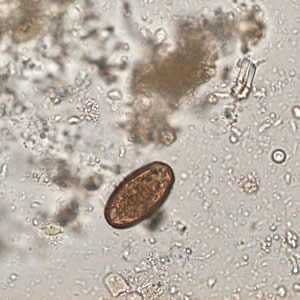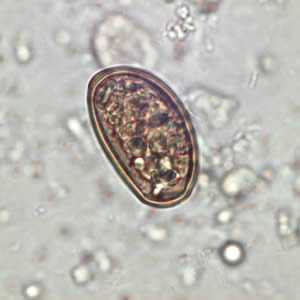
Case #198 - February, 2007
A 28-year-old male immigrant who had resided in Spain for the last five years, went to a physician complaining of general malaise and itching. The patient had slight eosinophilia but 15 days later was asymptomatic with no alteration in the differential blood count. Ova and parasite examinations of three stool specimens were negative, and the patient had an ultrasound of the biliary tract and abdomen showed no abnormalities. The patient admitted to regularly eating liver of locally raised sheep and cattle. Figures A-C show what was seen in a concentrated stool sample; the objects measured 37 to 45 micrometers by 25 micrometers. What is your diagnosis? Based on what criteria?

Figure A

Figure B

Figure C
Case Answer
The objects shown were eggs of the hepatic trematode, Dicrocoelium dentriticum. Diagnostic features were:
- eggs that were ovoid in shape, brown color, and with an inconspicuous operculum.
- eggs within the size range for D. dentriticum.
Dicrocoelium dentriticum requires two intermediate hosts; the first intermediate host is one of several species of land snails and the second intermediate host is an ant. The ants are ingested by herbivores such as sheep and cattle. For humans to become infected, they would have to ingest metacercariae-infected ants. Eating raw or undercooked liver from an infected animal can result in a spurious (i.e., false) infection. This infection was most likely spurious based on the case history given.
More on: Dicrocoeliasis
This case and images were kindly contributed by Dr. Juan Cuadros González.
Images presented in the monthly case studies are from specimens submitted for diagnosis or archiving. On rare occasions, clinical histories given may be partly fictitious.
DPDx is an education resource designed for health professionals and laboratory scientists. For an overview including prevention and control visit www.cdc.gov/parasites/.
- Page last reviewed: August 24, 2016
- Page last updated: August 24, 2016
- Content source:
- Global Health – Division of Parasitic Diseases and Malaria
- Notice: Linking to a non-federal site does not constitute an endorsement by HHS, CDC or any of its employees of the sponsors or the information and products presented on the site.
- Maintained By:


 ShareCompartir
ShareCompartir